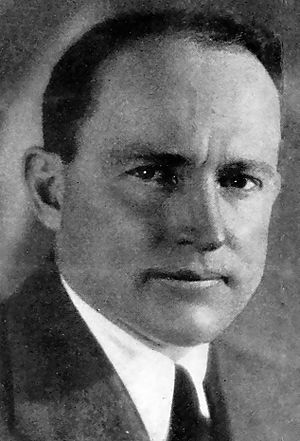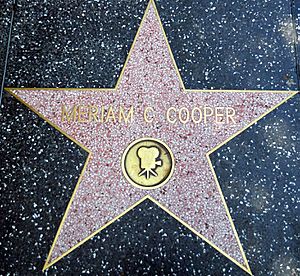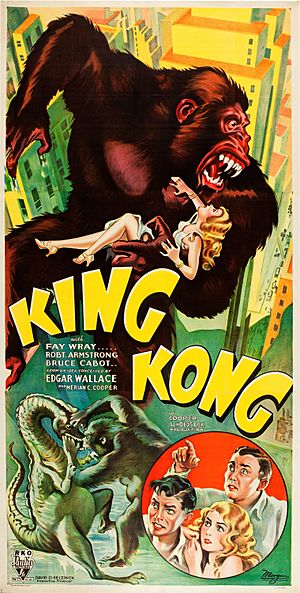Merian C. Cooper facts for kids
Quick facts for kids
Merian C. Cooper
|
|
|---|---|

Merian C. Cooper in 1927
|
|
| Born |
Merian Caldwell Cooper
October 24, 1893 |
| Died | April 21, 1973 (aged 79) |
| Nationality | American |
| Alma mater | |
| Occupation |
|
| Military career | |
| Allegiance | |
| Service/ |
|
| Years of service |
|
| Rank | Brigadier General (US) Podpułkownik (PL) |
| Battles/wars | |
| Awards |
|
Merian Caldwell Cooper (October 24, 1893 – April 21, 1973) was an American filmmaker and a brave aviator. He served as an officer in both the United States Air Force and the Polish Air Force. In the world of movies, he helped invent the Cinerama film projection process, which made movies feel more immersive.
Cooper's most famous film was the 1933 classic King Kong. He received an honorary Oscar in 1952 for his amazing career. He also has a star on the Hollywood Walk of Fame. Before making movies, Cooper had an exciting military career. He even founded the Kościuszko Squadron during the Polish–Soviet War and was a prisoner of war for a while. He loved adventure and travel, which led him to film.
Contents
Becoming an Explorer and Filmmaker
Merian Caldwell Cooper was born in Jacksonville, Florida. He was the youngest of three children. When he was just six years old, he decided he wanted to be an explorer. This dream came from reading exciting stories about adventures in Africa.
He went to The Lawrenceville School in New Jersey and finished in 1911. After school, Cooper was accepted into the U.S. Naval Academy. However, he was later expelled because he was a bit of a troublemaker and strongly believed in the power of airplanes.
In 1916, Cooper worked as a reporter for a newspaper. He also worked for other newspapers in the following years.
Early Military Adventures
Joining the Georgia National Guard
In 1916, Cooper joined the Georgia National Guard. He helped chase after Pancho Villa in Mexico. He was called home in March 1917. Cooper was offered a promotion to lieutenant, but he turned it down. He wanted to be in combat. Instead, he went to a military school in Atlanta to learn how to fly. He was the best in his class.
Flying in World War I
In October 1917, Cooper went to France during World War I. He joined the 201st Squadron. One time, while flying, he hit his head and passed out during a steep dive. He had to learn how to fly again after this accident.
Cooper became a bomber pilot with the United States Army Air Service. On September 26, 1918, his plane was shot down and caught fire. Cooper managed to land the burning plane, but he was injured and thought to be dead. German soldiers were amazed by his landing and took him to a hospital as a prisoner.
After the war, Captain Cooper stayed in the Air Service. He helped with a program that provided food aid to Poland. He later became the head of the Poland division.
The Kościuszko Squadron
From 1919 to 1921, Cooper was part of a group of American volunteer pilots called the Kościuszko Squadron. They helped the Polish Army in the Polish–Soviet War. On July 13, 1920, his plane was shot down again. This time, he spent almost nine months in a Soviet prisoner of war camp. He managed to escape just before the war ended and made it to Latvia.
For his bravery, Polish commander Józef Piłsudski gave him Poland's highest military award, the Virtuti Militari.
While he was a prisoner, Cooper wrote a book about his experiences. He later decided to remove almost all copies of the book. An old Polish film was even inspired by Cooper's time as a Polish Air Force officer. Sadly, after World War II, all copies of this film in Poland were destroyed by the Soviets.
A Career in Film
Adventures with Ernest Schoedsack
After returning from overseas in 1921, Cooper worked for The New York Times. He also wrote articles for Asia magazine. He traveled with his friend Ernest Schoedsack on a sea voyage. They visited Abyssinia (now Ethiopia) and met the prince, who later became Emperor Haile Selassie I.
In 1924, Cooper joined Schoedsack and Marguerite Harrison on an expedition. This trip became the film Grass (1925), a documentary about the Bakhtiari people. This film caught the eye of Jesse Lasky at Paramount Pictures. He asked Cooper and Schoedsack to make another film, Chang (1927). They also made The Four Feathers. These films mixed real footage with planned scenes.
Working with Pan American Airways
Between 1926 and 1927, Cooper helped plan Pan American Airways, which started in 1927. Cooper was on the company's board of directors. During his time there, Pan Am started the first regular flights across the Atlantic Ocean. Even though he was on the board, Cooper's love for movies was strong. He spent time in 1929 and 1930 working on the script for King Kong. He left Pan Am's board in 1935 due to health issues.
Creating King Kong
Cooper said he got the idea for King Kong from a dream. He dreamed of a giant gorilla causing chaos in New York City. When he woke up, he wrote down the idea for a movie.
Making King Kong was going to be very expensive, especially during the Great Depression. Cooper helped David Selznick get a job at RKO Pictures, a film studio that was having money problems. Selznick became a vice president at RKO and asked Cooper to join him in September 1931. Cooper officially presented his idea for King Kong in December 1931. He started looking for actors and building huge sets even before the script was finished.
The script was ready in January 1932. Schoedsack helped by filming the boat scenes and native village scenes. Cooper focused on the jungle scenes. There were many creative disagreements during filming. Some at RKO wanted the movie to start with Kong right away. But Cooper believed a film should have a "slow dramatic buildup" to introduce everything before the action began. So, he chose not to start with Kong. The famous scene where Kong is on top of the Empire State Building was almost cut for legal reasons. However, it stayed in the film because RKO bought the rights to The Lost World, which helped them with the legal issues.
Cooper and Schoedsack also worked on The Most Dangerous Game at the same time as King Kong.
In the 1933 King Kong movie, Cooper and Schoedsack even appear at the end. They are the pilots in the plane that finally defeats Kong. Cooper also removed a scene where giant spiders eat sailors. This was because audiences were too scared or distracted by the scene during early viewings. Later, in 1976, judges decided that Cooper's family owned the rights to King Kong outside of the movie and its sequel.
Pioneer Pictures and Technicolor
In 1933, Cooper helped form Pioneer Pictures. He became the vice president in charge of production in 1934. He used Pioneer Pictures to try out new technicolor film ideas. The company made films like She and The Last Days of Pompeii. Cooper later said She was the "worst picture I ever made."
Despite these challenges, Pioneer Pictures released a short film called La Cucaracha in three-strip technicolor, which was very popular and won an Academy Award in 1934. Pioneer then released the first full-length technicolor film, Becky Sharp in 1935. Cooper was a big supporter of technicolor and also of Cinerama, a widescreen film process.
Pioneer Pictures later joined with Selznick International Pictures in 1936. Cooper became a vice president there but left in 1937 due to disagreements about a film called Stagecoach. After that, Cooper went to Metro-Goldwyn-Mayer (MGM) in 1937. He worked on a fantasy film called War Eagles, which was never finished.
World War II Service
Cooper joined the military again and became a colonel in the U.S. Army Air Forces. He served in India and helped with the Doolittle Raid, a famous air attack. He also helped set up the "Hump" Airlift, which flew supplies over the Himalayas.
Colonel Cooper later served in China as chief of staff for General Claire Lee Chennault of the China Air Task Force. On October 25, 1942, Colonel Cooper led a successful bombing raid on the Kowloon Docks in Hong Kong.
From 1943 to 1945, he was chief of staff for the Fifth Air Force's Bomber Command. At the end of the war, he was promoted to brigadier general. He was even on the USS Missouri to witness Japan's surrender.
Argosy Pictures and Cinerama
After the war, Cooper and his friend, director John Ford, started Argosy Productions in 1946. They produced famous films like Wagon Master (1950), Fort Apache (1948), and She Wore a Yellow Ribbon. Cooper's films at Argosy showed his love for the United States.
Argosy also produced Mighty Joe Young, which had Schoedsack as director. Cooper visited the set every day to check on the movie's progress.
Cooper later left Argosy Pictures to focus on Cinerama. He became the vice president of Cinerama Productions in the 1950s. He wanted to make more movies using Cinerama, but the company only made a few. Cooper was the executive producer for The Searchers (1956), which was also directed by Ford.
Awards and Recognition

For his military service in Poland, Cooper received the Silver Cross of the Order of Virtuti Militari and Poland's Cross of Valour.
In 1927, the Boy Scouts of America named Cooper an "Honorary Scout." This was for his "achievements in outdoor activity, exploration and worthwhile adventure" that inspired boys. Other famous honorees included Charles Lindbergh and Orville Wright.
In 1949, Mighty Joe Young won an Academy Award for Best Visual Effects. This award went to Willis O'Brien, who created the special effects for the film.
Cooper received an honorary Oscar for his lifetime achievements in 1952. He also has a star on the Hollywood Walk of Fame.
Personal Life
Merian Cooper was the father of Polish writer and translator Maciej Słomczyński. He married film actress Dorothy Jordan on May 27, 1933. They kept their marriage a secret from Hollywood for a month. He had a heart attack later that year. In the 1950s, he supported Joseph McCarthy in his efforts to find Communists in Hollywood and Washington, D.C.
Cooper passed away from cancer on April 21, 1973, in San Diego. His ashes were scattered at sea with full military honors.
Filmography
| Year | Title | Director | Producer | Writer | Cinematographer | Notes |
|---|---|---|---|---|---|---|
| 1924 | The Lost Empire | No | No | Titles | No | Also editor |
| 1925 | Grass: A Nation's Battle for Life | Yes | Yes | No | Yes | Role: Himself; Documentary |
| 1927 | Chang: A Drama of the Wilderness | Yes | Yes | Yes | No | Documentaries |
| 1928 | Gow the Head Hunter | No | No | No | Yes | |
| 1929 | Captain Salisbury's Ra-Mu | No | No | No | Yes | |
| The Four Feathers | Yes | Yes | No | Yes | ||
| 1931 | Gow the Killer | No | No | No | Yes | Documentary |
| 1932 | Roar of the Dragon | No | No | Story | No | |
| 1933 | King Kong | Yes | Yes | Story | No | Role: Pilot of plane that kills Kong |
| 1935 | The Last Days of Pompeii | Yes | Yes | No | No | |
| 1949 | Mighty Joe Young | No | Yes | Story | No | Also presenter |
| 1952 | This Is Cinerama | Yes | Yes | No | No | Documentary |
| Only Producer | |||
|---|---|---|---|
| Year | Title | Producing role | Notes |
| 1932 | The Most Dangerous Game | Associate producer | |
| Flaming Gold | Executive producer | ||
| The Phantom of Crestwood | Associate producer | ||
| 1933 | The Monkey's Paw | Producer | |
| Lucky Devils | Associate producer | ||
| Diplomaniacs | Executive producer | ||
| The Silver Cord | |||
| Emergency Call | |||
| Cross Fire | |||
| Professional Sweetheart | |||
| Melody Cruise | |||
| Bed of Roses | |||
| Flying Devils | |||
| Double Harness | |||
| Headline Shooter | |||
| Before Dawn | |||
| No Marriage Ties | |||
| Morning Glory | |||
| Blind Adventure | |||
| One Man's Journey | |||
| Rafter Romance | |||
| Midshipman Jack | |||
| Ann Vickers | |||
| Aggie Appleby, Maker of Men | |||
| Ace of Aces | |||
| After Tonight | |||
| Chance at Heaven | |||
| Little Women | |||
| The Right to Romance | |||
| If I Were Free | |||
| The Son of Kong | Also characters | ||
| Flying Down to Rio | |||
| 1934 | Stingaree | Presenter | |
| The Meanest Gal in Town | Executive producer | ||
| Man of Two Worlds | |||
| Long Lost Father | |||
| Two Alone | |||
| Hips, Hips, Hooray! | |||
| The Lost Patrol | |||
| Keep 'Em Rolling | |||
| Spitfire | |||
| Success at Any Price | |||
| This Man Is Mine | |||
| Sing and Like It | |||
| Finishing School | |||
| Kentucky Kernels | |||
| 1935 | She | Producer | |
| 1936 | Dancing Pirate | Executive producer | |
| 1938 | The Toy Wife | Producer | |
| 1940 | Dr. Cyclops | ||
| 1947 | The Fugitive | Presenter, producer | |
| 1948 | Fort Apache | Presenter, executive producer | |
| 3 Godfathers | Presenter, producer | ||
| 1949 | She Wore a Yellow Ribbon | Presenter, executive producer | |
| 1950 | Wagon Master | ||
| Rio Grande | Producer | ||
| 1952 | The Quiet Man | ||
| 1953 | The Sun Shines Bright | ||
| 1956 | Seven Wonders of the World | Documentary | |
| The Searchers | Executive producer | ||
| 1963 | Best of Cinerama | Co-producer | Documentary |
Images for kids
See also
 In Spanish: Merian C. Cooper para niños
In Spanish: Merian C. Cooper para niños





